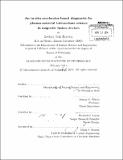| dc.contributor.advisor | Dennis G. Whyte. | en_US |
| dc.contributor.author | Hartwig, Zachary Seth | en_US |
| dc.contributor.other | Massachusetts Institute of Technology. Department of Nuclear Science and Engineering. | en_US |
| dc.date.accessioned | 2014-05-23T19:37:12Z | |
| dc.date.available | 2014-05-23T19:37:12Z | |
| dc.date.copyright | 2014 | en_US |
| dc.date.issued | 2014 | en_US |
| dc.identifier.uri | http://hdl.handle.net/1721.1/87488 | |
| dc.description | Thesis: Ph. D., Massachusetts Institute of Technology, Department of Nuclear Science and Engineering, 2014. | en_US |
| dc.description | Cataloged from PDF version of thesis. | en_US |
| dc.description | Includes bibliographical references (pages 149-162). | en_US |
| dc.description.abstract | Plasma-material interactions (PMI) in magnetic fusion devices such as fuel retention, material erosion and redeposition, and material mixing present significant scientific and engineering challenges, particularly for the next generation of devices that will move towards reactor-relevant conditions. Achieving an integrated understanding of PMI, however, is severely hindered by a dearth of in-situ diagnosis of the plasma-facing component (PFC) surfaces. To address this critical need, this thesis presents an accelerator-based diagnostic that nondestructively measures the evolution of PFC surfaces in-situ. The diagnostic aims to remotely generate isotopic concentration maps that cover a large fraction of the PFC surfaces on a plasma shot-to-shot timescale. The diagnostic uses a compact, high-current radio-frequency quadrupole accelerator to inject 0.9 MeV deuterons into the Alcator C-Mod tokamak. The tokamak magnetic fields in between plasma shots are used to steer the deuterons to PFCs where the deuterons cause high-Q nuclear reactions with low-Z isotopes ~5 [mu]m into the material. Scintillation detectors measure the induced neutrons and gammas; energy spectra analysis provides quantitative reconstruction of surface concentrations. An overview of the diagnostic technique, known as accelerator-based in-situ materials surveillance (AIMS), and the first AIMS diagnostic on the Alcator C-Mod is given; a description of the complementary simulation tools is also provided. Experimental validation is shown to demonstrate the optimized beam injection into the tokamak, the quantification of PFC surfaces isotopes, and the measurement localization provided by magnetic beam steering. Finally, the first AIMS measurements of fusion fuel retention are presented, demonstrating the local erosion and codeposition of deuterium-saturated boron surface films. The finding confirms that deuterium codeposition with boron is insufficient to account for the net fuel retention in Alcator C-Mod. | en_US |
| dc.description.statementofresponsibility | by Zachary Seth Hartwig. | en_US |
| dc.format.extent | 162 pages | en_US |
| dc.language.iso | eng | en_US |
| dc.publisher | Massachusetts Institute of Technology | en_US |
| dc.rights | M.I.T. theses are protected by copyright. They may be viewed from this source for any purpose, but reproduction or distribution in any format is prohibited without written permission. See provided URL for inquiries about permission. | en_US |
| dc.rights.uri | http://dspace.mit.edu/handle/1721.1/7582 | en_US |
| dc.subject | Nuclear Science and Engineering. | en_US |
| dc.title | An in-situ accelerator-based diagnostic for plasma-material interactions science in magnetic fusion devices | en_US |
| dc.type | Thesis | en_US |
| dc.description.degree | Ph. D. | en_US |
| dc.contributor.department | Massachusetts Institute of Technology. Department of Nuclear Science and Engineering | |
| dc.identifier.oclc | 879666805 | en_US |
